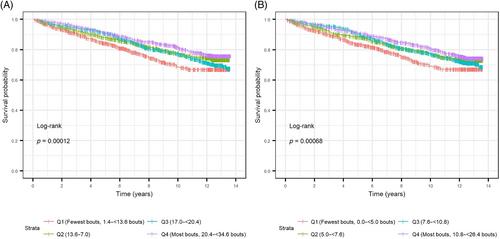Lauren S. Roe, Stephanie Harrison, Peggy M. Cawthon, Kristine Ensrud, Kelley Pettee Gabriel, Deborah M. Kado, Jane A. Cauley, the Osteoporotic Fractures in Men (MrOS) Study Research Group
下载PDF
{"title":"打破久坐时间可以降低老年男性复发性跌倒的风险,但不会降低意外骨折的风险","authors":"Lauren S. Roe, Stephanie Harrison, Peggy M. Cawthon, Kristine Ensrud, Kelley Pettee Gabriel, Deborah M. Kado, Jane A. Cauley, the Osteoporotic Fractures in Men (MrOS) Study Research Group","doi":"10.1002/jbm4.10803","DOIUrl":null,"url":null,"abstract":"<p>Apart from physical activity volume, frequent breaks from sedentary bouts and active bouts may differentially reduce fall and fracture risk. We assessed the longitudinal relationship between frequency of breaks from time spent sedentary and frequency of active bouts with recurrent falls and fractures. The sample included 2918 men aged 79.0 ± 5.1 years with free-living activity (SenseWear Armband) at the Osteoporotic Fractures in Men Study (MrOS) year 7 (2007–2009) visit. Men were divided into quartiles by the number of breaks from sedentary bouts (sedentary bout: 5+ minutes sedentary; <1.5 metabolic equivalents of task [METS]) and separately by active bout frequency (active bout: 5+ minutes of activity; ≥1.5 METS). Recurrent falls (2+ falls/year) and fractures were ascertained by self-report; fractures were radiographically confirmed. Generalized estimating equations estimated the recurrent fall odds, with restricted cubic splines applied to assess nonlinear relationships. Cox proportional hazards models estimated fracture risk. Over 4 years of follow-up after year 7, 1025 (35.1%) men were fallers. Over 8.40 ± 4.10 years of follow-up, 640 (21.9%) men experienced a fracture. There was a significant nonlinear U-shaped relationship between number of breaks from sedentary bouts and recurrent falls (<i>p</i> < 0.001); compared with men with few breaks from sedentary bouts (1.4–<13.6), the odds of recurrent falls were lower with a moderate number (13.6–<17.0, odds ratio [OR] = 0.82, 95% confidence interval [CI] 0.66, 1.01; 17.0–<20.4, OR = 0.79, 95% CI 0.64, 0.99), but not with the highest number of breaks from sedentary bouts (20.4–34.6, OR = 1.01, 95% CI 0.81, 1.27). Results remained borderline significant after adjusting for total sedentary time. Men with the highest compared with the lowest number of breaks from sedentary bouts had a lower fracture risk, but the association was attenuated after adjustment for total sedentary time. No associations were observed for active bout frequency. In conclusion, breaking up extended periods of sedentary time reduces fall risk regardless of total sedentary time. © 2023 The Authors. <i>JBMR Plus</i> published by Wiley Periodicals LLC. on behalf of American Society for Bone and Mineral Research.</p>","PeriodicalId":14611,"journal":{"name":"JBMR Plus","volume":"7 12","pages":""},"PeriodicalIF":3.4000,"publicationDate":"2023-08-07","publicationTypes":"Journal Article","fieldsOfStudy":null,"isOpenAccess":false,"openAccessPdf":"https://asbmr.onlinelibrary.wiley.com/doi/epdf/10.1002/jbm4.10803","citationCount":"0","resultStr":"{\"title\":\"Breaking Up Sedentary Time Reduces Recurrent Fall Risk, but Not Incident Fracture Risk in Older Men\",\"authors\":\"Lauren S. Roe, Stephanie Harrison, Peggy M. Cawthon, Kristine Ensrud, Kelley Pettee Gabriel, Deborah M. Kado, Jane A. Cauley, the Osteoporotic Fractures in Men (MrOS) Study Research Group\",\"doi\":\"10.1002/jbm4.10803\",\"DOIUrl\":null,\"url\":null,\"abstract\":\"<p>Apart from physical activity volume, frequent breaks from sedentary bouts and active bouts may differentially reduce fall and fracture risk. We assessed the longitudinal relationship between frequency of breaks from time spent sedentary and frequency of active bouts with recurrent falls and fractures. The sample included 2918 men aged 79.0 ± 5.1 years with free-living activity (SenseWear Armband) at the Osteoporotic Fractures in Men Study (MrOS) year 7 (2007–2009) visit. Men were divided into quartiles by the number of breaks from sedentary bouts (sedentary bout: 5+ minutes sedentary; <1.5 metabolic equivalents of task [METS]) and separately by active bout frequency (active bout: 5+ minutes of activity; ≥1.5 METS). Recurrent falls (2+ falls/year) and fractures were ascertained by self-report; fractures were radiographically confirmed. Generalized estimating equations estimated the recurrent fall odds, with restricted cubic splines applied to assess nonlinear relationships. Cox proportional hazards models estimated fracture risk. Over 4 years of follow-up after year 7, 1025 (35.1%) men were fallers. Over 8.40 ± 4.10 years of follow-up, 640 (21.9%) men experienced a fracture. There was a significant nonlinear U-shaped relationship between number of breaks from sedentary bouts and recurrent falls (<i>p</i> < 0.001); compared with men with few breaks from sedentary bouts (1.4–<13.6), the odds of recurrent falls were lower with a moderate number (13.6–<17.0, odds ratio [OR] = 0.82, 95% confidence interval [CI] 0.66, 1.01; 17.0–<20.4, OR = 0.79, 95% CI 0.64, 0.99), but not with the highest number of breaks from sedentary bouts (20.4–34.6, OR = 1.01, 95% CI 0.81, 1.27). Results remained borderline significant after adjusting for total sedentary time. Men with the highest compared with the lowest number of breaks from sedentary bouts had a lower fracture risk, but the association was attenuated after adjustment for total sedentary time. No associations were observed for active bout frequency. In conclusion, breaking up extended periods of sedentary time reduces fall risk regardless of total sedentary time. © 2023 The Authors. <i>JBMR Plus</i> published by Wiley Periodicals LLC. on behalf of American Society for Bone and Mineral Research.</p>\",\"PeriodicalId\":14611,\"journal\":{\"name\":\"JBMR Plus\",\"volume\":\"7 12\",\"pages\":\"\"},\"PeriodicalIF\":3.4000,\"publicationDate\":\"2023-08-07\",\"publicationTypes\":\"Journal Article\",\"fieldsOfStudy\":null,\"isOpenAccess\":false,\"openAccessPdf\":\"https://asbmr.onlinelibrary.wiley.com/doi/epdf/10.1002/jbm4.10803\",\"citationCount\":\"0\",\"resultStr\":null,\"platform\":\"Semanticscholar\",\"paperid\":null,\"PeriodicalName\":\"JBMR Plus\",\"FirstCategoryId\":\"1085\",\"ListUrlMain\":\"https://onlinelibrary.wiley.com/doi/10.1002/jbm4.10803\",\"RegionNum\":0,\"RegionCategory\":null,\"ArticlePicture\":[],\"TitleCN\":null,\"AbstractTextCN\":null,\"PMCID\":null,\"EPubDate\":\"\",\"PubModel\":\"\",\"JCR\":\"Q2\",\"JCRName\":\"ENDOCRINOLOGY & METABOLISM\",\"Score\":null,\"Total\":0}","platform":"Semanticscholar","paperid":null,"PeriodicalName":"JBMR Plus","FirstCategoryId":"1085","ListUrlMain":"https://onlinelibrary.wiley.com/doi/10.1002/jbm4.10803","RegionNum":0,"RegionCategory":null,"ArticlePicture":[],"TitleCN":null,"AbstractTextCN":null,"PMCID":null,"EPubDate":"","PubModel":"","JCR":"Q2","JCRName":"ENDOCRINOLOGY & METABOLISM","Score":null,"Total":0}
引用次数: 0
引用
批量引用


 求助内容:
求助内容: 应助结果提醒方式:
应助结果提醒方式:


